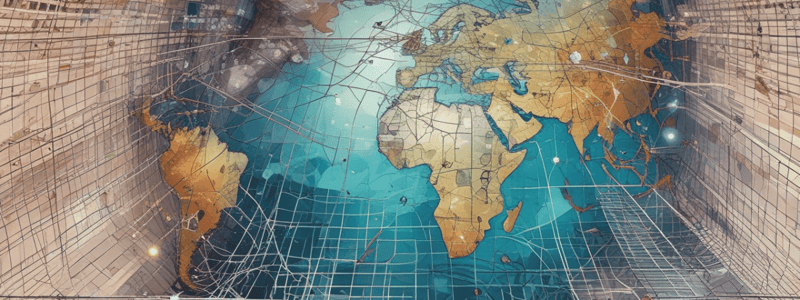Podcast
Questions and Answers
What is the primary goal of the agent in a grid world?
What is the primary goal of the agent in a grid world?
- To push boxes to specific locations
- To navigate to a goal while avoiding obstacles (correct)
- To maximize rewards in a stochastic environment
- To find the shortest path to a goal state
What is the purpose of the discount factor γ in a Markov Decision Process (MDP)?
What is the purpose of the discount factor γ in a Markov Decision Process (MDP)?
- To calculate the expected future rewards (correct)
- To define the set of possible actions
- To determine the next state in a stochastic environment
- To specify the reward function for state transitions
What is the main difference between a deterministic and stochastic environment?
What is the main difference between a deterministic and stochastic environment?
- The complexity of the environment
- The number of possible actions
- The predictability of outcomes for actions (correct)
- The type of reward function used
What is an irreversible environment action?
What is an irreversible environment action?
What is the purpose of the transition probabilities Ta in a Markov Decision Process (MDP)?
What is the purpose of the transition probabilities Ta in a Markov Decision Process (MDP)?
What is the main characteristic of a box puzzle?
What is the main characteristic of a box puzzle?
What is the purpose of the state representation in a Markov Decision Process (MDP)?
What is the purpose of the state representation in a Markov Decision Process (MDP)?
What is the main difference between a discrete and continuous action space?
What is the main difference between a discrete and continuous action space?
What is the characteristic of Monte Carlo methods in terms of bias and variance?
What is the characteristic of Monte Carlo methods in terms of bias and variance?
What is the difference between On-Policy SARSA and Off-Policy Q-Learning?
What is the difference between On-Policy SARSA and Off-Policy Q-Learning?
What is the purpose of Reward Shaping in reinforcement learning?
What is the purpose of Reward Shaping in reinforcement learning?
What is the characteristic of Temporal Difference methods in terms of bias and variance?
What is the characteristic of Temporal Difference methods in terms of bias and variance?
What is the purpose of -greedy Exploration in reinforcement learning?
What is the purpose of -greedy Exploration in reinforcement learning?
What is the purpose of the Q-Table in Q-Learning?
What is the purpose of the Q-Table in Q-Learning?
What is the main advantage of the agent being able to choose its training examples in reinforcement learning?
What is the main advantage of the agent being able to choose its training examples in reinforcement learning?
What is the primary goal of an agent in a Grid world environment?
What is the primary goal of an agent in a Grid world environment?
What are the five essential elements of an MDP?
What are the five essential elements of an MDP?
What direction does the successor selection of behavior occur in a tree diagram?
What direction does the successor selection of behavior occur in a tree diagram?
What direction does the learning values through backpropagation occur in a tree diagram?
What direction does the learning values through backpropagation occur in a tree diagram?
What represents a sequence of state-action pairs in reinforcement learning?
What represents a sequence of state-action pairs in reinforcement learning?
What is the expected cumulative reward starting from state s and following policy π?
What is the expected cumulative reward starting from state s and following policy π?
What is the method for solving complex problems by breaking them down into simpler subproblems?
What is the method for solving complex problems by breaking them down into simpler subproblems?
What is the primary approach to problem-solving used in recursion?
What is the primary approach to problem-solving used in recursion?
What is the main purpose of value iteration?
What is the main purpose of value iteration?
Which of the following environments may have irreversible actions?
Which of the following environments may have irreversible actions?
What are two typical application areas of reinforcement learning?
What are two typical application areas of reinforcement learning?
What type of action space does robotics typically have?
What type of action space does robotics typically have?
What is the primary characteristic of the environment in games?
What is the primary characteristic of the environment in games?
What is the goal of reinforcement learning?
What is the goal of reinforcement learning?
Which concept is less emphasized in episodic problems?
Which concept is less emphasized in episodic problems?
What type of action space is suited for value-based methods?
What type of action space is suited for value-based methods?
Why are value-based methods used for games?
Why are value-based methods used for games?
What are two basic Gym environments?
What are two basic Gym environments?
What is the biological name of Reinforcement Learning?
What is the biological name of Reinforcement Learning?
What are the two central elements of Reinforcement Learning Interaction?
What are the two central elements of Reinforcement Learning Interaction?
What is the main problem of assigning reward?
What is the main problem of assigning reward?
What is the name of the recursion relation central to the value function?
What is the name of the recursion relation central to the value function?
What is the characteristic of model-free methods?
What is the characteristic of model-free methods?
Study Notes
Grid Worlds, Mazes, and Box Puzzles
- Examples of environments where an agent navigates to reach a goal
- Goal: Find the sequence of actions to reach the goal state from the start state
Grid Worlds
- A rectangular grid where the agent moves to reach a goal while avoiding obstacles
Mazes and Box Puzzles
- Complex environments requiring trajectory planning
- Box Puzzles (e.g., Sokoban): Puzzles where the agent pushes boxes to specific locations, with irreversible actions
Tabular Value-Based Agents
Agent and Environment
- Agent: Learns from interacting with the environment
- Environment: Provides states, rewards, and transitions based on the agent’s actions
- Interaction: The agent takes actions, receives new states and rewards, and updates its policy based on the rewards received
Markov Decision Process (MDP)
- Defined as a 5-tuple (S, A, Ta, Ra, γ)
- S: Finite set of states
- A: Finite set of actions
- Ta: Transition probabilities between states
- Ra: Reward function for state transitions
- γ: Discount factor for future rewards
State S
- Representation: The configuration of the environment
- Types:
- Deterministic Environment: Each action leads to a specific state
- Stochastic Environment: Actions can lead to different states based on probabilities
State Representation
- Description: How states are defined and represented in the environment
Action A
- Types:
- Discrete: Finite set of actions (e.g., moving in a grid)
- Continuous: Infinite set of actions (e.g., robot movements)
Irreversible Environment Action
- Definition: Actions that cannot be undone once taken
Exploration
- Bandit Theory: Balances exploration and exploitation
- -greedy Exploration: Chooses a random action with probability , and the best-known action with probability 1-
Off-Policy Learning
- On-Policy SARSA: Updates policy based on the actions taken by the current policy
- Off-Policy Q-Learning: Updates policy based on the best possible actions, not necessarily those taken by the current policy
Q-Learning
- Description: Updates value estimates based on differences between successive state values
Temporal Difference Learning
- Description: Updates value estimates based on differences between successive state values
Monte Carlo Sampling
- Description: Generates random episodes and uses returns to update the value function
Bias-Variance Trade-off
- Monte Carlo methods have high variance and low bias, while temporal difference methods have low variance and high bias
Studying That Suits You
Use AI to generate personalized quizzes and flashcards to suit your learning preferences.
Related Documents
Description
Navigate through grid worlds, mazes, and box puzzles to reach a goal state while avoiding obstacles and planning trajectories.





